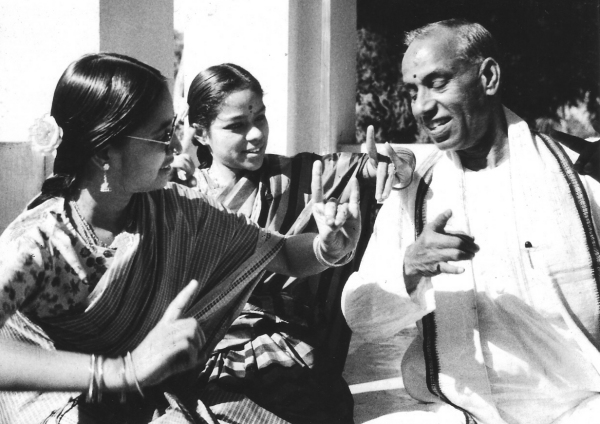What we know as Bharata Natyam today springs from
Sadir Natyam, also known by names like
Daasi Attam,
Chinna Mélam, or simply,
Sadir.
 |
| source : Notice that the procession is being let by a dancer? |
Origin
Surviving texts of the golden age of Tamil literature and poetry known during the Sangam Age such as the Tolkappiyam (read:
thol-kaapi-yum), as well as the later Silappadikaram (read:
Si-luh-puh-dhi-kaa-rum), testify to a variety of dance traditions which flourished in these times. The Silappadikaram is a mine of information of ancient Tamil culture, in which the arts of music and dance were highly developed and played a major role.
 |
| source: a famous scene from the Silapathikaram - the story of Kannagi |
The Natyashaastra tells an epic story of the celestial
dancers (Apsaraas) and musicians
(Gandharvaas) who enacted and celebrated, with dance, music and drama, the
Devaas' (God’s) victorious battle against the Asuraas (demons). This divine dance
was then brought to humanity as Devadasi Sadir (the dance of the Devadaasis, Servants of God). Bharata declared that
dance, “Shall be the happy adoration of
the world."
In ancient times it was performed as 'Dasi Attam' (read: Daa-see-aa-tum) by Hindu temple Devadaasis. Many of the ancient sculptures in Hindu temples are based on Bharatanatyam dance postures (karanas). Basically, a Hindu deity is a revered royal guest in his temple, to be offered the "sixteen hospitalities" - among which are music and dance, pleasing to the senses. Thus, many Hindu temples traditionally maintained complements of trained musicians and dancers, as did Indian rulers.
 |
| source: a sculpture in a south Indian temple |
The term 'Sadir' (read: Suh-dhyr) began with the Maratha rulers of South India in the 17th century, who called the dance 'Sadir Nautch'. This corresponds to the presentation of the dance in the courts. However, the dance didn't develop much in Northen India due to frequent foreign invasions. Fortunately, the dance tradition survived in South India, where it continued to be patronized by kings and maintained by the devadaasi system.
A Milestone
An important milestone in the evolution of Bharatanatyam was the development of the
current format of the Bharatanatyam recital which happened in the
late
18th century, at the hands of four brothers from Thanjaavur (read:
thun-jaa-voor). They were the four sons of the N
attuvanaar
Subbarayan:-
Chinnayya,
Ponnayya,
Vadivelu, and
Sivanandam. They also
refined the music of Bharatanatyam, influenced by their musical
mentor, the great composer
Muthuswamy Dikshitar. These developments
shaped
Sadir into the
predecessor of what we call Bharatanatyam today.
 |
source: Bharatanatyam - 18th century
|
British Rule
Under British rule, propaganda prevailed against Indian art, falsifying it as immoral and inferior to the concepts of
Western civilization. This influence was extensive enough to discourage
the patronage of royal courts for the Dance and to alienate
educated Indians from their traditions. Even the terms by which the dance was known –
Sadir,
Nautch,
Dasi Attam etc. took on offensive implications. In the early
20th centuries, social reformers under Western influence took advantage
of these circumstances, launching an
Anti-Nautch movement to eradicate the art itself, condemning it as a social evil. By the first
quarter of the 20th century, the classical dance of South India was
almost wiped out, even in Tamil Nadu.
 |
source: a pic from the Anti Nautch campaign
|
Revival
Against many
odds, a few families preserved the knowledge of this Dance
tradition. Its revival involved individuals from different backgrounds: freedom fighters, westerners interested in Indian arts, people
outside the
devadasi (servant) class who learned Bharatanatyam, and
devadaasis
themselves
One such person was E. Krishna Iyer. He was a freedom fighter and lawyer who also had learned Bharatanatyam. He would perform the dance in female costume to remove the
stigma associated with the dance, and campaigned to raise public
interest in the art. He also founded the Music Academy
in Chennai and used its platform to present Bharatanatyam
performances by
devadaasis. The art gained respect due to its acceptance on the Music
Academy stage.
 |
| source: E Krishna Iyer explaining hastas to daughter Meenakshi on left and MK Saroja, centre |
Bharatanatyam then attracted artists from respectable families. Initially met with shock, their participation ultimately
helped to shift public opinion in favor of reviving the art. Two such people who played an important role in reviving the dance were Kalanidhi Narayanan of Mylapore and
Rukmini Devi of Adyar.
Rukmini Devi’s first performance in 1935 was another milestone. Her efforts
won over much of the orthodox communities. Her reforms of
costume, stage setting, musical accompaniment, and thematic
content, overcame the objections of conservative people. She went on to found the (now world famous)
Kalakshetra institute. The renewed awareness of Bharatanatyam in Indian society encouraged various styles of the dance to be recognized such as
Pandanallur,
Vazhuvur, and
Thanjavur. (more on this later)
 |
| Source: Rukmini Devi Arundale, founder of Kalakshetra |
Bharata Natyam quickly gained international recognition and became on of India's most prized Art form. Today, there are even more variations of the dance. Some are recognized as traditional styles while some modern contemporary styles are gaining popularity too. However, the question of 'preserving' the ancient art has one too many opinions. We'll talk about that later...
Take Care! :-)






I'm really looking forward....................
ReplyDeletewow- so much information ; kavi you rock gal :)
ReplyDelete